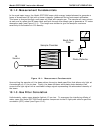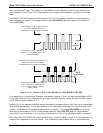
Model GFC7000E Instruction Manual THEORY OF OPERATION
04584 Rev A1 153
10. THEORY OF OPERATION
The Model GFC7000E Gas Filter Correlation Carbon Dioxide Analyzer is a microprocessor-
controlled analyzer that determines the concentration of carbon dioxide (CO
2
) in a sample gas
drawn through the instrument. It requires that sample and calibration gasses be supplied at
ambient atmospheric pressure in order to establish a stable gas flow through the sample chamber
where the gases ability to absorb infrared radiation is measured.
Calibration of the instrument is performed in software and does not require physical adjustments
to the instrument. During calibration the microprocessor measures the current state of the IR
Sensor output and various other physical parameters of the instrument and stores them in
memory.
The microprocessor uses these calibration values, the ir absorption measurements made on the
sample gas along with data regarding the current temperature and pressure of the gas to
calculate a final co
2
concentration.
This concentration value and the original information from which it was calculated are stored in
one of the unit’s internal data acquisition system (iDAS - see Sections 6.12) as well as reported to
the user via a vacuum florescent display or a variety of digital and analog signal outputs.
10.1. Measurement Method
10.1.1. Beer’s Law
The basic principle by which the analyzer works is called Beer’s Law. It defines the how light of a
specific wavelength is absorbed by a particular gas molecule over a certain distance. The
mathematical relationship between these three parameters is:
I = I
o
e
-αLc
Where:
I
o
is the intensity of the light if there was no absorption.
I is the intensity with absorption.
L is the absorption path, or the distance the light travels as it is being absorbed.
C is the concentration of the absorbing gas. In the case of the Model GFC7000E,
carbon dioxide (CO
2
).
α is the absorption coefficient that tells how well CO
2
absorbs light at the specific
wavelength of interest.


















